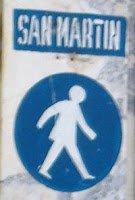 It's been a year since I bought my digital camera. I'd discovered the pleasure of photography before, but the equipment didn't match my expectations as to what constitutes a good picture. This camera really opened up a world of opportunities.
It's been a year since I bought my digital camera. I'd discovered the pleasure of photography before, but the equipment didn't match my expectations as to what constitutes a good picture. This camera really opened up a world of opportunities.
The first advantage of a digital camera is, of course, the ability to waste freely and for free — as you can take a thousand pictures of the same object with slightly different camera settings and ambient lighting, and from variable angles and distances, without worrying about the film running out or the future price of developing it.
The second advantage is quality. Granted my camera is not a superior one. Any modern reflex camera that is not below average quality, operated by the proper hands, can produce better pictures than my humble Fujifilm FinePix A345. Although the comparison is difficult, I get it that, on average, a picture taken by a reflex camera and printed on good paper has the equivalent of a 9 megapixel resolution; mine is only 4 Mpx. Cameras above 7 Mpx are still rare and extremely expensive in Argentina, where imported electronic equipment is burdened by high taxes and reaches us months after it's become standard in the developed world. Anyway, the quality is fine enough to me, and it's far better than many common reflex cameras in the market.
Average reflex cameras may not have a good focus control and don't automatically compensate for bad lightning, high contrast, etc. The circuitry and software of a digital camera handle those naturally, and in any case you can edit the picture as an image file later without losing time and quality by scanning a printed picture.
The ability to shoot many pictures one after another in a few minutes was the one I made most of. I'm impatient and I'm not a pro; I can't stand shooting a picture and then having to wait to see how it turned out, and I don't have the equipment to look at the film to choose one particular picture and discard the rest, not to speak of the waste of money. I'd been thinking of a camera and I made the mistake of going to Mendoza in January 2006 without buying it, as I didn't find it financially safe at the time. Fortunately my travel mate took his own camera, so we didn't miss the chance to get nice shoots, and this additionally convinced me that I should have one of these wonderful apparatuses. I got it one month later and started going around Rosario, picturing anything remotely curious or well-built that crossed my path. I discovered places I'd never been to in my life, and things I'd never laid eyes on, even as they were there all the time I've lived here. I took interest in the history of Rosario. I got accustomed to looking up and around while walking, searching for little architectural features, clever graffiti, weird objects from weird angles.
I got it one month later and started going around Rosario, picturing anything remotely curious or well-built that crossed my path. I discovered places I'd never been to in my life, and things I'd never laid eyes on, even as they were there all the time I've lived here. I took interest in the history of Rosario. I got accustomed to looking up and around while walking, searching for little architectural features, clever graffiti, weird objects from weird angles.
This blog is in part a result of that search and discovery. After I took a lot of pictures, I started showing them to the world, joining the flood of content produced by common people and posted to the web that has become a trend. Yet many pictures were not worth more than a thousand words, or even close. I love pictures that are beautiful and complex in and of themselves, but I also love pictures that have a complex significance only explainable from the outside. Certain political graffiti are a good example, as are seemingly plain old buildings with a history.
I've even considered making my own photo book. Amid the thousands of trial-and-error byproducts there are a few true gems that I could conceivably collect, comment and print out. I'm not a paper person — I'm perfectly OK with watching photos in a computer screen as long as it's got a good resolution. I'd do this for myself, but I wouldn't do it unless I could pay for it by selling the book. If you, my loyal reader, have any suggestion, please write!
19 February 2007
My digital camera
Subscribe to:
Post Comments (Atom)


Pablo - I too like taking photgraphs of graffiti and objects from weird angles. It's sometimes a challenge in Europe to actually figure out what the graffiti artists are trying to convey.
ReplyDelete